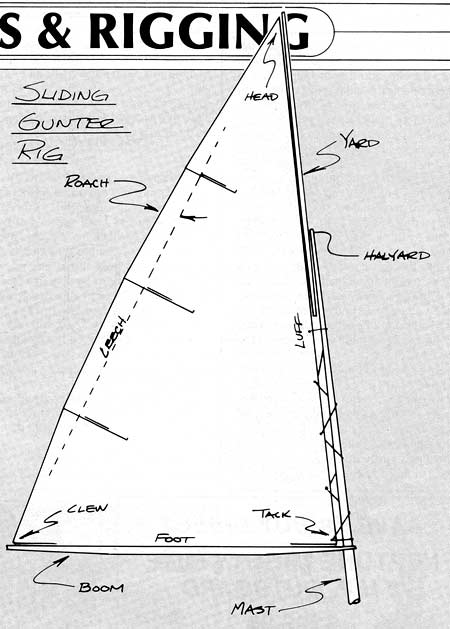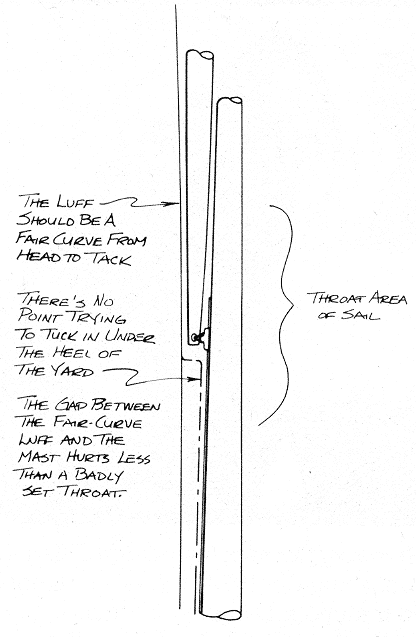|
Sliding Gunter Rig
By Chris Wentz drawings by the author
from Small Boat Journal #42 May. 1985
At first glance, the sliding gunter rig
would appear to be the ideal rig for
small craft. It sports a profile very similar
to the popular Bermuda or Marconi rig,
yet its spars may be shorter for the sail
area spread than any other rig with a
triangular sail. This rig saw much development at the turn of the century, when
interest in small cruising vessels resulted
in some wonderful canoe yachts that
still stand as works of marine art. But
today the gunter rig is mostly seen in
dinghies, where it offers the possibility
of an efficient sail with spars short
enough to stow entirely inside the boat.
In some respects, the gunter rig compares favorably with its cousin the Bermuda rig, but it has inadequacies that
have rightfully kept it from being widely
popular.
The principal liability of the rig is the
yard, the spar that extends the luff of the
sail above the masthead (Yes, it's called
a yard despite its resemblance to a gaff).
Like a gaff, the pressures of the wind on
the sail make the yard tend to twist off to
leeward with a consequent loss of efficiency. Ideally, the yard would he firmly
fixed against the mast, as though held by
a splint. The problem is to design a joint
that sets rigidly, yet may be lowered away instantly.
Some wonderful schemes have been
concocted to set the yard properly. Generally, the heel of the yard is fixed to a
slide, and the halyard holds the upper
part of the yard to the masthead. The
halyard also guides the yard into a clip that seats the yard and holds it fast when
the halyard is belayed. The trick is to
make the clip strong enough to withstand a bashing from a recalcitrant yard,
without it being unduly clumsy, heavy,
or complicated.

Saggy Yards
As clever as the rigging methods may
be, one drawback of the gunter rig has
defied satisfactory solution: making the
yard stand properly with a reefed sail.
When sail is reduced, the yard sets at a lower postion, and the halyard's attachment point on the yard moves away
from the halyard sheave. As a result, the
halyard can't accurately guide the yard
into the clip, and the yard sags off. The
more deeply the sail is reefed, the worse
it sets. One could move the halyard's
attachment higher up the yard, but reefing down a small boat in a breeze usually gives one enough to do without
having to re-rig the boat as well.
In addition to the gunter rig's reefing
problems and its need for special fittings, many sailmakers simply have trouble cutting a sail to Fit the gunter. They
seem lo think that the luff of the sail
must hug the spars very closely. As a
result, the throat of most gunter sails
tuck in right under the base of the yard
to join the mast immediately. Unfortunately sharp lucks and cut-ins in the luff
of a sail do not benefit its shape. Better
to simply fair the luff back to meet the
throat.

Since the result is a nice efficient leg-o-mutton sail, all of this trouble might
be worthwhile. But sprit or lug rigs
using short spars can easily spread half
again the sail area, thereby boosting performance greatly despite their reduced
efficiency. Furthermore, sprits and lugs
don't require special fittings or tricky sail making, and if all that sail gets to be a
bit much, they reef perfectly.
Efficient Sail
Despite its drawbacks, the gunter rig
was once popular on small cruising
yachts, some of which did extensive
coastwise sailing. The designers of
those craft did their best to accentuate the positive and eliminate the negative.
They used two-masted rigs and designed
their vessels to balance well in a breeze
under jib and mizzen only. This is when
the benefit of the short mainmast is fully
enjoyed. With minimal unwanted windage and a low center of gravity, this is a
very good heavy weather rig indeed, especially for small craft that by nature
aren't terribly stiff.

If a breezy passage is expected, a trysail can be set on the mainmast without
the yard. These sails aren't great performers, being short of luff length for
their area, but if it really starts to blow, a
wee ship with gunter rig can heave to
under the trysail very nicely. Or, depending on how much sea room one
has, she can lie head to wind with just
her mizzen and a sea anchor.
The sliding gunter rig is ideally suited
to small craft on which a triangular sail
plan is desired, in which all spars must
be easily stowed, and aboard which a
skipper must be able to set and strike
the rig. If you always sail in pleasant
weather, and avoid having to reef, so
much the better.
Chris Wentz is a founder of Z Sails
|

